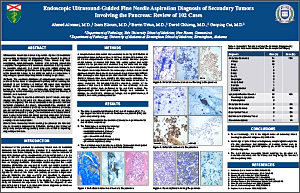Endoscopic Ultrasound-Guided Fine Needle Aspiration Diagnosis of Secondary Tumors Involving the Pancreas: Review of 102 Cases
Ahmed Alomari, M.D.1, Isam Eltoum, M.D.2, Berrin Ustun, M.D.1, David Chhieng, M.D.1, Guoping Cai, M.D.1
1Department of Pathology, Yale University School of Medicine, New Haven, CT; 2Department of Pathology, University of Alabama at Birmingham School of Medicine, Birmingham, AL, USA
ABSTRACT
Introduction. Pancreatic masses may seldom represent a metastasis or secondary involvement by lymphoproliferative disorders in patients with or without history of malignancy. These tumors may have overlapping cytomorphologic features with primary pancreatic neoplasms. Recognition of this uncommon occurrence may help render an accurate diagnosis and avoid diagnostic pitfalls during the endoscopic ultrasound-guided fine needle aspiration (EUS-FNA) biopsy of the pancreatic lesions. In this study we review our experience in diagnosing non-pancreatic primary tumors involving the pancreas.
Methods. The electronic databases of cytopathology archives were searched for the cases of non-pancreatic primary tumors involving the pancreas in our institutions. A total of 102 cases were identified. Ancillary studies including immunostains and flow cytometry were performed in 75 cases. The corresponding cytopathology reports including the results of ancillary studies, clinical history, and follow-up, if available, were reviewed.
Results. The patients consisted of 55 male and 47 female, with ages ranging from 39 to 91 years old. Seventy-seven patients had prior history of malignancy. The tumors metastatic to the pancreas included metastatic carcinoma (74 cases), lymphoproliferative disorders (16 cases), metastatic melanoma (5 cases), metastatic sarcoma (3 cases), granular cell tumor (2 cases), gastrointestinal stromal tumor (1 case) and pheochromocytoma (1 case). The most common metastatic tumors were renal cell carcinoma (19 cases) and lung carcinoma (16 cases). Other primary sites included skin, breast, colon, ovary, head & neck, esophagus and urinary bladder.
Conclusions. Secondary tumors involving the pancreas are rare and can be accurately diagnosed by EUS-FNA. Knowing prior history of malignancy and performing ancillary studies are crucial for improving diagnostic performance.
©2012 Yale Department of Pathology. All rights reserved.
Any redistribution or reproduction of part or all of the contents in any form is prohibited. You may not, except with express written permission of the author or the Department of Pathology, distribute or commercially exploit the content, nor may you transmit it or store it in any other website or other form of electronic retrieval system, including use for educational purposes.
